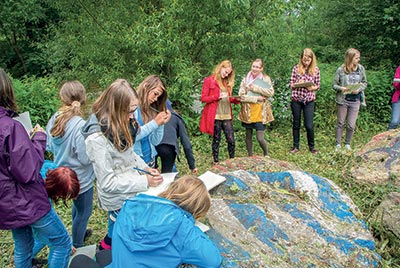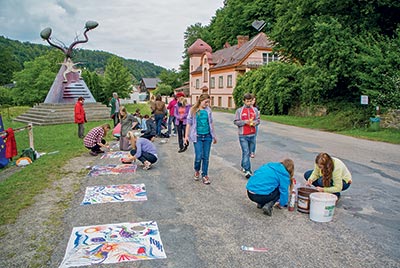Painting at Kristek’s Sculptures(1)
26–27 June 2013, entire Kristek Thaya Glyptotheque
At the end of June 2013, Kristek developed his idea to involve the public in the creative process and set off along the stations of his Glyptotheque with Czech and Austrian students(2). The entire pilgrims’ way has become a meeting place and a platform for creation. At a time when the media is dictating a cult of beauty or “ideal” lifestyle, the artist meets students on a pilgrimage. Together they take a bus along the route from the source to the confluence; they visit the stations and, most importantly, they create. Kristek emphasises the physical meeting in an inspirational place and creation freed of dogma. He didn’t want to teach the students. On this two-day journey, he inspired them to look with their own eyes.
 On the first day, they sketched the individual stations. Kristek wanted them to work with what surrounded them, i.e., what was visible and what was not visible. So some of them sketched reality, and others transformed it in their own way. On the second day, colour entered the process, and in the end the students came together at a joint canvas. One picture corresponded to each station, and the task was to express the feelings from the visited places in an abstract manner. Here it was seen that a diversity of views is a benefit during collective creation. Everyone complemented and improved the work of the others, regardless of linguistic or other barriers. Then Kristek used the canvases to create a joint assemblage, and a fantasy map of Kristek Thaya Glyptotheque was created.
On the first day, they sketched the individual stations. Kristek wanted them to work with what surrounded them, i.e., what was visible and what was not visible. So some of them sketched reality, and others transformed it in their own way. On the second day, colour entered the process, and in the end the students came together at a joint canvas. One picture corresponded to each station, and the task was to express the feelings from the visited places in an abstract manner. Here it was seen that a diversity of views is a benefit during collective creation. Everyone complemented and improved the work of the others, regardless of linguistic or other barriers. Then Kristek used the canvases to create a joint assemblage, and a fantasy map of Kristek Thaya Glyptotheque was created.
 During work with students, Kristek placed the emphasis primarily on the actual process of creation, not on the finished work. He is interested in the meaning of art at a time when it has become a media and commercial article, in a period that is overloaded with symbols. This is a time when many works do not arise from a natural impulse but from calculated reasoning(3). He gets under the surface of things and offers these impulses when the public gets involved in creation. He inspires participants to use their own senses and own imagination. He opens a gateway for them into the world of creativity for them to carry away their testimony in the form of a work. But in this sense, the work is merely a trace left by the creative process, and it should initiate the further creative process. So Kristek's aim here is not the creation of a work of art, but the evoking of conditions for joint creation, and he understands creation to be a means of perceiving, a temporarily excited existence. Via the creative process, a man develops, and everything that he discovers is part of the journey and may become redundant in the further process.
During work with students, Kristek placed the emphasis primarily on the actual process of creation, not on the finished work. He is interested in the meaning of art at a time when it has become a media and commercial article, in a period that is overloaded with symbols. This is a time when many works do not arise from a natural impulse but from calculated reasoning(3). He gets under the surface of things and offers these impulses when the public gets involved in creation. He inspires participants to use their own senses and own imagination. He opens a gateway for them into the world of creativity for them to carry away their testimony in the form of a work. But in this sense, the work is merely a trace left by the creative process, and it should initiate the further creative process. So Kristek's aim here is not the creation of a work of art, but the evoking of conditions for joint creation, and he understands creation to be a means of perceiving, a temporarily excited existence. Via the creative process, a man develops, and everything that he discovers is part of the journey and may become redundant in the further process.
 Collective artistic creation puts everyone on a single level and binds the group together. The creative process is the glue that binds society together. During joint creation, Kristek takes the participants into other worlds. It is not hyperreality masquerading as day-to-day reality. The worlds that Kristek visits are inside each and every one of us and are subject to no diktat. And only journeys to inner space can bring meetings with that which exceeds man. The discovery of one’s own roots gives one wings. Then one returns from these alternative worlds to one's own day-to-day reality, and what one experienced can be an impulse for a change in one's own patterns of thought or behaviour.
Collective artistic creation puts everyone on a single level and binds the group together. The creative process is the glue that binds society together. During joint creation, Kristek takes the participants into other worlds. It is not hyperreality masquerading as day-to-day reality. The worlds that Kristek visits are inside each and every one of us and are subject to no diktat. And only journeys to inner space can bring meetings with that which exceeds man. The discovery of one’s own roots gives one wings. Then one returns from these alternative worlds to one's own day-to-day reality, and what one experienced can be an impulse for a change in one's own patterns of thought or behaviour.
The foundations of new cooperation were laid during the painting at Kristek’s sculptures. The assemblage was exhibited at Chateau Lubo in Podhradí nad Dyjí, then at the castle Hardegg and then in Znojmo at the Dr. Karel Polesný Grammar School, where another meeting of students and their discussion with Lubo Kristek took place.



